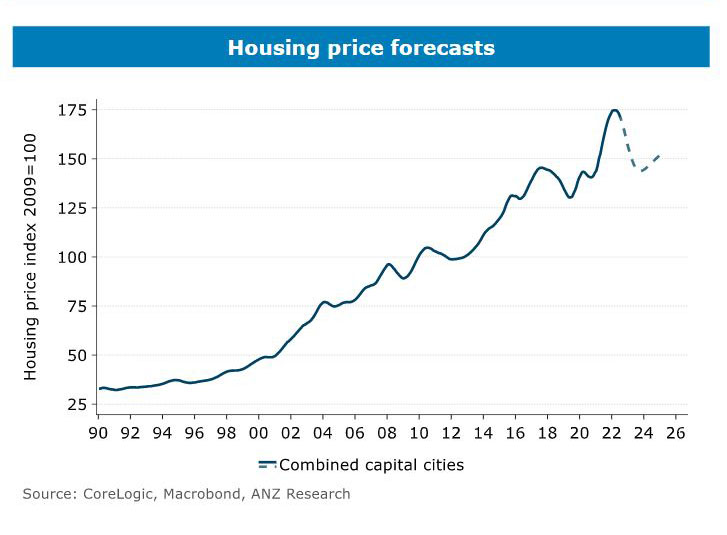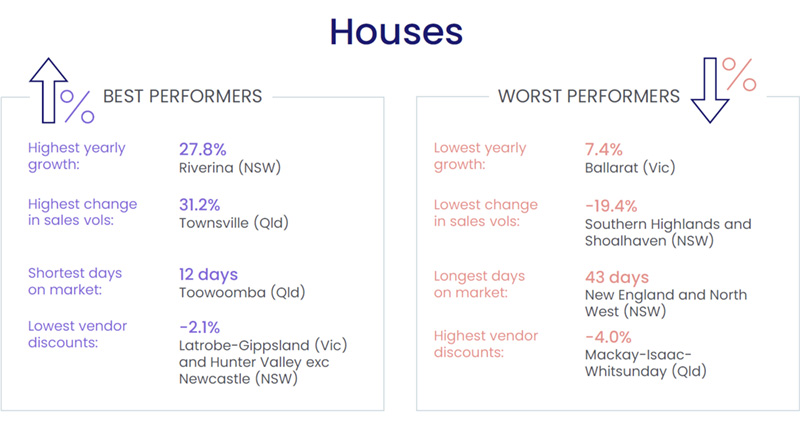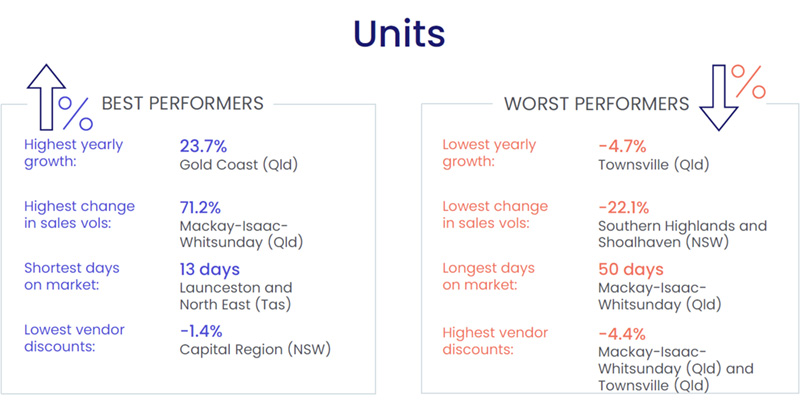Regional property's party year nears closing time
A year of record-breaking real estate price hikes for regional property markets is finally faltering, with 10 of the 25 largest non-capital city regions recording a fall in property values in the last quarter.
The regional property party’s not quite over but the first guests are leaving.
After a year of record-breaking profits driven by a flight from cities to regional lifestyle centres during the height of the pandemic, prices in Australia’s regional centres are now experiencing the same slowdown that has gripped the capital cities.
In a year of dancing tunes, balloons and champagne corks, the largest 25 non-capital city regions all recorded an increase in house values for the year.
While the hangovers may still be some time away, 10 of the 25 guests at this particular bush bash have jumped in a taxi and headed back to town.
Annual figures show regional dwelling values jumped 17.0 per cent, outpacing the combined capitals, which saw dwelling values rise 5.4 per cent over the same period.
Despite the widespread capital gains in regional house values, 10 regions recorded value declines in the three months to July, in a clear sign the sizzle was subsiding.

CoreLogic’s latest quarterly Regional Market Update revealed revellers in the New South Wales Riverina region enjoyed the biggest celebrations over the year among regional markets, with an annual increase of 27.8 per cent, followed by Wide Bay (Queensland) and New England and North West (NSW), up 26.8 per cent and 26.4 per cent respectively.
The lowest yearly growth rate was recorded across Ballarat in Victoria (7.4 per cent), followed by Bunbury in Western Australia (9.5 per cent), which were both still solid performers in their own right.
The growth in regional dwelling values has slowed from a peak of 6.4 per cent in December last year to edge backwards by 0.2 per cent over the three months to July 2022.
The largest quarterly falls in house values occurred in the Richmond-Tweed region, down 4.5%, followed by Illawarra (-3.5 per cent) and Southern Highlands and Shoalhaven (-3.0 per cent), all located in NSW.

Source: CoreLogic.
In Victoria, the regional areas led the charge in the state, with median prices holding strong across houses, units and apartments.
The median house price in regional Victoria saw a 21.6 per cent annual increase from $500,000 to $608,000. Units in regional Victoria peaked to $418,000 in the June quarter reaching a new price record and shot up 14.5 per cent over the financial year.
This compared to the best metropolitan market, outer Melbourne, which only rose 12.6 per cent in that time.
Real Estate Institute of Victoria data revealed some exceptional price growth, such as in Horsham, where median house prices have spiked more than 40 per cent ($393,750), but that there are also still plenty of bargains in the bush.
Stawell sits top of the list offering homebuyers a $322,500 median, despite showing an annual 26.5 per cent increase. Morwell offers a median price tag of $325,000, after recording an annual 30 per cent increase.
Turning down the volume
With Sydney and Melbourne leading the charge in real price retreats, the expectation now is that regional property prices will follow and continue their moderating trend.
As interest rates move higher and affordability pressures mount, CoreLogic Economist, Kaytlin Ezzy, said it’s likely the decline in values witnessed in capital cities will become more widespread and impact regional areas.
“Value declines are already being seen across more expensive regional markets, while the pace of growth has eased considerably across the combined regions’ broad middle and lower quartile markets,” she said.
“However, as Australia’s housing market moves further into the downwards phase of the cycle, it’s possible the regional areas will be slightly more insulated than the capitals, thanks to these markets’ relative affordability and low advertised supply levels.
“Additionally, the strong growth that’s occurred over the past two years should help cushion regional homeowners from the most extreme effects of the cycle’s downturn.”
While sales volume across some of these regional markets was down compared to the previous year, Ms Ezzy said it’s important to remember this is off the back of some extremely high sales volumes the year before.
Strong interstate migration over the past year helped fuel an increase in sales activity across regional Queensland, lifting the national regional sales volumes 1.4 per cent higher in the year to May, and almost 30 per cent above the five-year average.
As a result, Queensland had the top three regions with the largest increase in sales volumes in the 12 months to May, with dwelling sales across Townsville up 34.2 per cent, followed by the Mackay–Isaac–Whitsunday region (29.6 per cent) and Central Queensland (28.1 per cent).
Falls in dwelling transaction volumes occurred in 15 of the 25 regions, with the Southern Highlands and Shoalhaven region in NSW recording the largest fall (-19.7 per cent), followed by Latrobe-Gippsland, VIC (-16.4 per cent) and Richmond-Tweed, NSW (-14.8 per cent).
“All but one of the markets analysed recorded a rise in dwelling sales compared to the regions previous five-year average,” Ms Ezzy said.
“A number of the regional areas that previously saw some of the strongest growth over the Covid period are now showing weaker selling conditions as consecutive rate hikes, affordability constraints, falling consumer sentiments and high non-discretionary inflation put further downwards pressure on demand.”

Source: CoreLogic.
Across Australia’s regional unit markets, Queensland’s Gold Coast and NSW’s Capital Region recorded the highest annual increase in values, up 23.7 per cent and 22.0 per cent respectively over the 12 months to July 2022.
At the other end of the scale, Townsville (Qld) was the only region to record a decline in unit values over the past year, down 4.7 per cent.
While all but one region saw an annual increase in unit values, seven saw unit values fall over the three months to July.
Richmond-Tweed (NSW, -3.8 per cent) recorded the largest quarterly fall in unit values, followed by Victoria’s Ballarat and Geelong regions, where unit values were down 3.2 per cent and 1.9 per cent respectively.
Calling time
Houses sold fastest in Toowoomba (Qld) where the median time on market was 12 days in the year to July 2022, down from 23 days compared to the previous 12 months.
Queensland’s Gold Coast and Tasmania’s Launceston and North East regions were second, each recording a median time on market of 17 days.
The slowest selling house region was once again the New England and North West region in NSW, where the median time on market was 43 days over the 12 months to July 2022, an improvement from the 72 days it took to sell a property in the year to July 2021.
While most markets are still recording faster selling times compared to this time last year, median days on market and vendor discounting figures have been creeping up in the past two quarters, Ms Ezzy said, suggesting buyers were starting to reign back some control.
“Vendors are now offering slightly larger discounts in order to secure a sale, while regional properties are now taking slightly longer to sell as selling conditions start to shift back in favour of buyers,” she said.



















